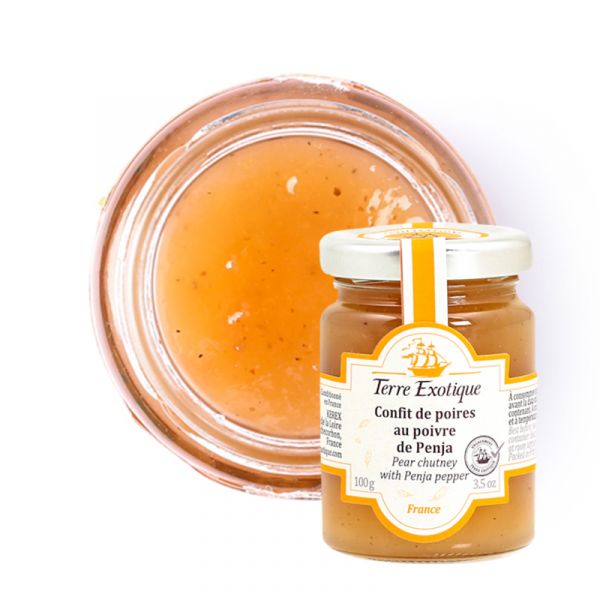



The intense aroma of Penja pepper pear confit
Penja pepper pear confit offers a harmonious marriage between the sweet sweetness of pears and the subtle and fragrant spiciness of Penja pepper. The aroma of this confit is characterized by the delicacy of ripe pears, enhanced by the spicy and warm notes of Penja pepper.
What dishes to use Penja pepper pear confit in?
Penja pepper pear confit, delicately spiced sweet pleasure, is particularly enjoyable with foie gras or on goat and sheep cheeses. The pepper paired with pear brings out the fruity and sweet notes of the fruit. You can use this condiment like fruit jam, in a verrine, as a condiment, as a mustard replacement, or in a yogurt for dessert.
How to use Penja pepper pear confit in cooking?
Here are some recipes for cooking Penja pepper pear confit:
- - gingerbread with Penja pepper pear confit: for the holidays, accompany your gingerbreads and foie gras with Penja pepper pear confit for an explosion of flavors;
- - fruit tart with Penja pepper pear confit: for all your fruit tart recipes (apples, pears, apricots...), spread a layer of Penja pepper pear confit on your pre-baked pastry and follow your preparation;
- - pork skewers with Penja pepper pear confit: during the last minutes of cooking your skewers, brush them with Penja pepper pear confit to coat them with a delicious glaze;
- - warm goat cheese salad with Penja pepper pear confit: prepare a sauce to accompany your salad by mixing Penja pepper pear confit, balsamic vinegar, olive oil, salt, and pepper. Drizzle your salad and sprinkle with walnut kernels.
- - chicken with Penja pepper pear confit: before baking your chicken breasts in the oven, brush them with Penja pepper pear confit, then bake for about 20 minutes. Remove from the oven and garnish with lemon slices and finely chopped parsley.
Pear, Penja pepper: a look at their botany
The pear, a delicious and juicy fruit, is the product of a fruit tree belonging to the species Pyrus communis. The pear is a drupe, a fleshy fruit with a stone, which develops from the flowers of the tree. Pear trees belong to the Rosaceae family, closely related to apple trees, and they are cultivated worldwide for their delicious pear varieties. These fruit trees produce an abundance of fruits usually in autumn, offering a variety of flavors, textures, and colors, ranging from sweet and melting pears to crispy and juicy pears.
Penja pepper comes from the plant piper nigrum, a species of pepper belonging to the Piperaceae family. Cultivated in the Penja region of Cameroon, this pepper is harvested when fully ripe. Penja pepper grains come from the plant's berries, which are sun-dried until they reach their characteristic texture.
How is Penja pepper pear confit made?
Pears are peeled, pitted, and cut into pieces, then gently cooked with sugar to obtain a melting texture. During cooking, Penja pepper is added, bringing its subtle and spicy aroma to the confit. This mixture is then reduced until it reaches a thick and syrupy consistency, allowing the flavors to blend perfectly. The confit is then placed in a sterilized jar to be preserved and enjoyed at leisure. This artisanal method preserves the integrity of the ingredients and offers an exquisite Penja pepper pear confit, ideal for accompanying a variety of sweet and savory dishes.
Penja pepper, a global culinary treasure
The history of Penja pepper dates back to the late 19th century when pepper plants were introduced to the Penja region, located in the Moungo province of Cameroon, by German colonists. The region proved to be exceptionally suitable for pepper cultivation due to its tropical climate, rich soil, and abundant rainfall. Over the decades, local farmers have perfected their techniques for growing and drying pepper, preserving its unique flavors. Penja pepper has gained a reputation for its exceptional quality, subtle flavor, and delicate aroma. In 2014, it became the first Protected Geographical Indication (PGI) in Africa.
| Price/kg | 56 |
|---|---|
| Allergen | Absence |
| Native country | FRANCE |
| Ingredients | pears (53%), cane sugar, fruit sugar, vin de Pays d'Oc, Penja pepper |
| (0.25%), gelling: fruit pectine. | |
| pH 3.4 / Brix : 50 | |
| Nutritional Info | VN Energie pour 100 g (energy for 100g) : 855 kJ / 205 kcal VN Matière grasse (fat) : 0.2 g Dont acide gras saturés (of which saturated fat) : 0 g VN Glucides (carbohydrate) : 50 g Dont sucres (of which sugars) : 50 g VN Protéines (protein) : 0.2 g Vn Sel (salt) : 0.04 g |
| Contenance | 100g |
| TRACES EVENTUELLES D'ALLERGÈNES | céleri, sésame, moutarde, fruits à coques. |
 Français
Français 








